So, what exactly is preservative free wine?
Put simply, it’s wine made without adding any sulphur dioxide (SO2) – a common preservative winemakers use to keep the wine stable and stop it from spoiling. It’s a bit like the difference between a loaf of bread fresh from the bakery and one from the supermarket shelf. One is made for immediate enjoyment, relying on its natural goodness, while the other is built to last.
Opting to go preservative free is a conscious winemaking choice, a commitment to a "less is more" philosophy in the cellar.
Unpacking Preservative Free Wine
When you see "preservative free" on a wine label, it might feel like a health claim, but it's really more of a winemaking philosophy. It signals a return to more traditional, hands-off methods where the natural quality of the grapes does all the talking.
Instead of using added preservatives as a safety net, winemakers have to be on their A-game. It means starting with pristine, top-quality fruit, maintaining obsessive cleanliness in the winery, and relying on the wine's own natural defences – things like tannins and acidity – to keep it fresh and vibrant.
This hands-off approach is really hitting the mark with a growing number of Aussies who are more curious than ever about where their food and drink come from. This isn't just a passing trend; it reflects a bigger shift towards natural and organic products. The numbers don't lie: organic wine sales, a category that often overlaps with preservative-free, have skyrocketed from just 100,000 cases in 2012 to 1.5 million cases by 2022.
That's a staggering compound annual growth rate of 31% per year, making it one of the fastest-growing wine categories on the planet. You can dig into more of this incredible growth data over at Wine Australia.
No Added Sulphites Explained
Here's a crucial detail: all wine has some naturally occurring sulphites. They’re a normal byproduct of fermentation, created by the yeast as it happily turns grape sugars into alcohol.
Because of this, a more precise term for these wines is "no added sulphites" or "no added preservatives".
The distinction is important: winemakers aren't taking anything out. They are simply choosing not to add the most common preservative, sulphur dioxide (SO2), which is typically used to control unwanted microbes and prevent the wine from oxidising.
This small but significant decision sends ripples through the entire winemaking process, demanding extra care and attention every step of the way, from the vineyard to the bottle. Sulphites are often misunderstood, but you can get the full story by demystifying sulfites in wine with our detailed guide.
Ultimately, choosing a preservative free wine means you’re getting a product that’s as close as you can get to pure, fermented grape juice, letting the true character of the fruit and the land it came from shine through.
The Art of Winemaking Without a Safety Net
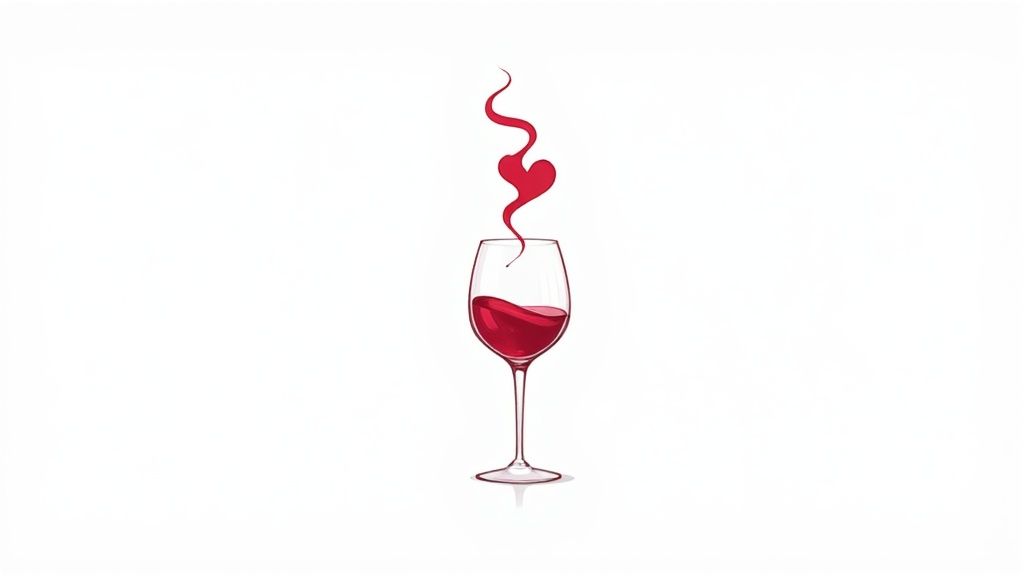
Making a brilliant preservative free wine isn’t about leaving things out; it’s about pouring meticulous care into every single step. It’s winemaking without a safety net, where everything hinges on precision, cleanliness, and the quality of the grapes.
Think of it like a master sushi chef. Their reputation relies entirely on the absolute freshness of their fish and immaculate hygiene—not additives—to create a perfect dish. It's the same philosophy.
This journey starts long before the grapes even see the inside of a cellar. It begins in the vineyard, with perfectly ripened, pristine fruit. Grapes must be hand-harvested with extreme care, ensuring they arrive at the winery whole and undamaged. This minimises any chance for unwanted bacteria to get a foothold.
A Sterile and Controlled Environment
Once the grapes are in the winery, the game changes. The focus shifts to creating an environment that naturally protects the wine from harm. The entire space has to be kept exceptionally clean, as any stray microbes can spoil a whole batch in the blink of an eye.
Winemakers also go to great lengths to minimise the wine's contact with oxygen, the enemy of fresh, vibrant flavours and aromas.
They pull this off with a few key techniques:
- Gentle Handling: The grapes are processed with the softest touch to avoid breaking the skins prematurely.
- Inert Gas Blanketing: Tanks and barrels are often flushed with inert gases like argon or nitrogen to push out every last bit of oxygen.
- Careful Racking: When moving the wine from one vessel to another, it's done with minimal splashing or exposure to air.
This painstaking process is a true testament to the winemaker's skill. Without the fallback of added preservatives, every single decision matters. It’s a philosophy often shared by producers of natural and biodynamic wines, who also champion minimal intervention. You can dive deeper into these related styles by exploring the mysteries of organic, biodynamic, and natural wine explained in our detailed guide.
Letting Nature Do the Work
Instead of adding sulphur, winemakers let the grape's own natural defences do the talking. The wine’s inherent structure becomes its shield, protecting it from spoilage and allowing it to develop gracefully in the bottle.
A wine's natural acidity and tannins act as its built-in immune system. High acidity creates an inhospitable environment for microbes, while tannins—the compounds that give red wine its structure and texture—have powerful antioxidant properties.
For red wines, robust tannins from the grape skins provide a strong defence against oxidation. For crisp whites, it’s a backbone of bright, zesty acidity that does the heavy lifting, keeping the wine fresh and lively.
It’s a delicate balancing act that requires a deep understanding of the vineyard and the cellar. The final result? A wine that is a pure, unadulterated expression of its fruit and the place it was grown—a true work of art, crafted with both passion and precision.
Benefits, Myths, and The Truth About Wine Headaches
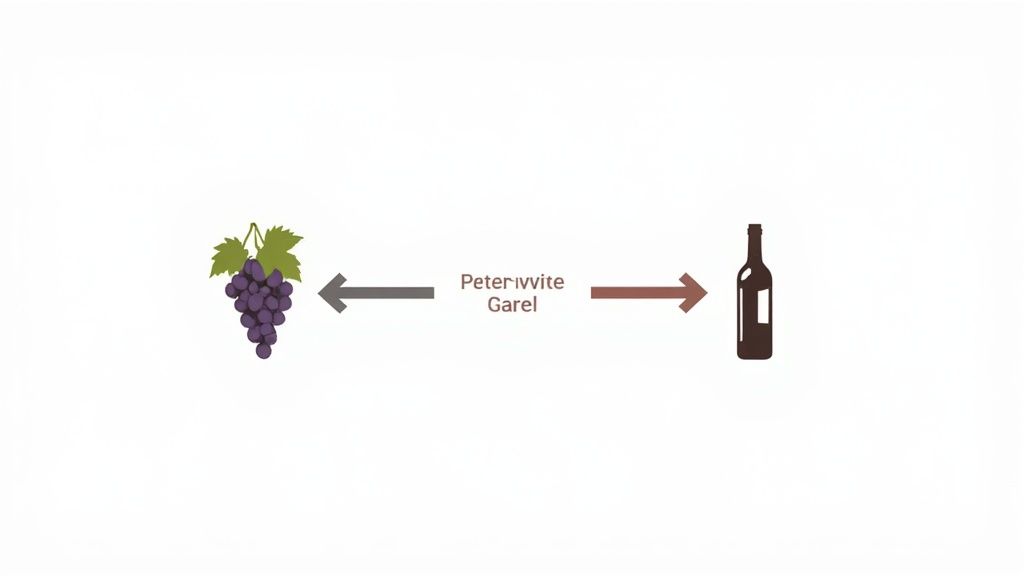
It’s easy to get swept up in the buzz around preservative free wine. And while some of the benefits are absolutely real, others are myths that have stuck around for far too long. Let's pour a glass, separate the facts from the fiction, and get to the bottom of why you might reach for a bottle with no added preservatives.
The clearest, most undeniable advantage is for people with a genuine sulphite sensitivity. While this is quite rare, for those affected—particularly people with asthma—it can trigger some really unpleasant reactions. Symptoms might be as mild as a stuffy nose or could escalate to more serious respiratory issues.
For these drinkers, choosing a wine without added sulphites isn't about following a trend. It's simply about avoiding a known trigger so they can enjoy a glass without worrying about the side effects. It’s a fantastic alternative in a market otherwise dominated by conventionally preserved wines.
Unlocking Purity of Flavour
Beyond sensitivities, many wine lovers gravitate towards preservative free bottles for one simple reason: the taste. Sulphur dioxide can sometimes mute the more delicate aromas in a wine, so when it's not there, the wine's natural character gets to take centre stage.
Think of it like the difference between a live acoustic set and a heavily produced studio album. Both can be brilliant, but the live performance has a raw, unfiltered honesty to it. That's what fans of preservative free wine are often looking for.
Without added preservatives, the most subtle notes of the fruit, the unique character of the vineyard's terroir, and the winemaker's skill can shine through. You're tasting the wine in its most direct, unadorned form.
This focus on authenticity often leads to wines that are incredibly vibrant and expressive, giving you a direct connection to the place they came from. It's a winemaking choice that puts the pure expression of the grape and its home first.
The Truth About Wine Headaches
Alright, let's tackle the big one: the myth that sulphites cause wine headaches. They take a lot of the blame, but the science just doesn't back it up for most people. That dreaded post-wine headache? It’s far more likely to be caused by other natural compounds in your glass.
Here are the usual suspects:
- Histamines: These compounds, found in grape skins, are more common in red wines. They can cause blood vessels in the brain to dilate, which for some people is a direct trigger for a headache.
- Tannins: Also coming from the skins, seeds, and stems, tannins give red wine its structure and that drying sensation. For a small group of people, they can also contribute to headaches.
- Alcohol: We often forget the most obvious culprit! Alcohol is a diuretic, which leads to dehydration—a primary cause of headaches and classic hangover symptoms.
So, while grabbing a preservative free wine might be the answer if you have a specific sulphite sensitivity, it’s not a magic bullet for the common wine headache. The best prevention is still the simplest: drink in moderation and make sure you stay hydrated. At the end of the day, "preservative free" isn't an automatic sign of quality, but rather a stylistic choice that offers a different, often purer, wine experience.
How to Read Wine Labels with Confidence
Walking into a bottle shop can feel a bit like reading a foreign language. But once you know what to look for, those labels become your best guide to choosing a preservative free wine you’ll actually love. Let’s break down the common terms so you can see past the marketing spin and know exactly what’s in your glass.
First up, the most direct claims: "Preservative Free" and "No Added Sulphur". You’ll often see these used interchangeably, and for good reason—they both mean the winemaker decided not to add any sulphur dioxide (SO2) during the winemaking process. This is the clearest sign you can get.
It’s worth remembering that all wines have tiny, trace amounts of sulphites that occur naturally during fermentation, so "no added" is the most accurate way to put it. This phrase signals a hands-off, minimal intervention approach where the winemaker is letting the quality of the grapes do all the talking.
Navigating Organic and Biodynamic Labels
Next, you'll see "Organic" and "Biodynamic" pop up a lot. While these wines often go hand-in-hand with the preservative free philosophy, the certification is actually all about what happens in the vineyard.
- Organic: This tells you the grapes were grown without any synthetic pesticides, herbicides, or fertilisers. The whole focus is on building healthy, living soil.
- Biodynamic: This takes the organic concept a step further. It treats the entire vineyard as one self-sustaining ecosystem, even following planting and harvesting cycles based on lunar calendars.
Now, here’s the important bit: while many organic and biodynamic winemakers choose to skip added preservatives, it's not a mandatory part of the certification. These labels guarantee how the grapes were farmed, not necessarily what happened back in the winery.
A wine can be made from organically grown grapes but still have added preservatives. To be certain, you need to look for both an organic certification and a "No Added Preservatives" statement on the label.
The Australian Certified Organic Standard does put strict limits on the amount of preservatives that can be used, ensuring they’re kept to a minimum. But minimal doesn't always mean zero.
To put this into context, Australia’s general limit for total sulphur dioxide in dry wines is 250 mg/L. Most conventional Aussie wines are already well below this, with 99% of reds under 160 mg/L and 99% of whites under 190 mg/L. For organic wines, these limits are even lower, which shows a real commitment to fewer additives. You can discover more insights about these regulations on the AWRI website.
Once you get the hang of these distinctions, you can navigate the wine aisle with confidence, picking out a bottle that perfectly matches what you’re looking for—whether that’s a purely preservative free drop, an organically farmed wine, or both.
Choosing, Storing, and Serving Your Wine
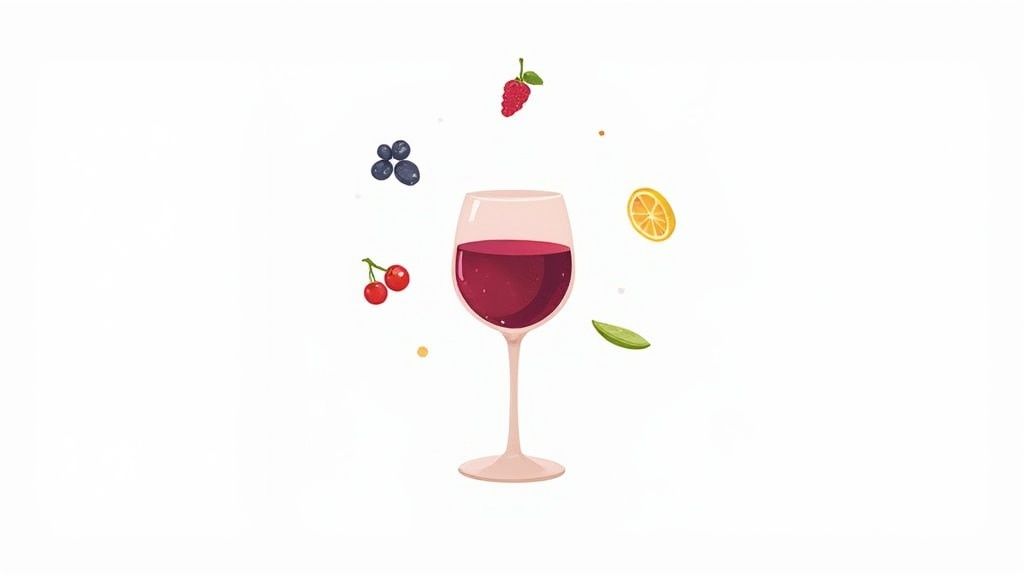
So, you’ve found a fantastic preservative free wine—brilliant! Now, let's make sure you get to enjoy every drop exactly as the winemaker intended. These wines are a little different from their conventional cousins, especially when it comes to their lifespan, so a bit of know-how goes a long way.
Think of preservative free wine like you would fresh produce from a farmer’s market, not something from a can. It’s at its absolute best when it’s young, fresh, and full of life. For this reason, you should always opt for the youngest vintage available. These wines are crafted to be enjoyed now, not tucked away in a cellar for years.
Their delicate nature makes them more vulnerable to the effects of time, so drinking them fresh is always the way to go.
Smart Storage for Delicate Wines
Because they don’t have that protective shield of added preservatives, these wines are incredibly sensitive to their environment. Heat, light, and big temperature swings are their worst enemies, as they can kickstart oxidation and mute the wine's vibrant character.
The good news is you don’t need a fancy, custom-built cellar to get it right. Just a few simple rules will do the trick:
- Find a Cool, Dark Spot: Keep your bottles in the coolest and darkest part of your home. A pantry, a cupboard, or even the bottom of a wardrobe works perfectly.
- Keep Out of the Kitchen: The kitchen is usually the warmest room in the house with temperatures that go up and down all day, making it a terrible spot for wine.
- Consistency is Key: A stable temperature is far more important than a perfectly cold one. Steer clear of spots that get direct sunlight or are near heat-producing appliances.
Proper storage is all about protecting the wine’s integrity. It ensures that when you finally pop that cork, the wine tastes just as it should—fresh, lively, and full of personality. For more detailed advice tailored to our unique climate, check out these essential wine storage tips for Australian weather conditions.
Serving and Finishing the Bottle
Once you've opened a bottle of preservative free wine, the clock starts ticking a little faster. Without those added sulphites to slow down the oxidation process, the wine’s beautiful aromas and flavours will begin to fade more quickly.
The golden rule here is to try and finish the bottle within 24-48 hours. If you can’t manage that, just pop the cork or screw cap back on and stick it in the fridge. The cold will help slow everything down.
If you’re wondering where to start your preservative free journey, keep an eye out for styles like a vibrant Pét-Nat or a juicy, fruit-forward Grenache. These are often made with minimal intervention and are stunning examples of just how good these wines can be.
Discover Australian Preservative Free Wineries
Alright, now that we've covered the what and why behind preservative free wine, let's get to the fun part: exploring the passionate Aussie producers who are mastering this craft. From the sun-drenched Barossa Valley to the cool climates of the Adelaide Hills, these wineries are creating some truly exceptional drops that let their unique slice of the country do all the talking.
This isn’t just about jumping on a trend. It's a genuine commitment to a winemaking philosophy that puts pristine fruit and a hands-off approach first. These producers are showing everyone what’s possible when incredible skill and nature work together.
Pioneers of the Movement
Across the country, a growing number of wineries are putting preservative free options front and centre. They are proving that with meticulous care in the vineyard and spotless work in the cellar, you can create stable, vibrant, and utterly delicious wines without relying on added sulphur.
Here are a few Australian regions and producers to look for:
- Barossa Valley: Famous for its bold reds, you'll find winemakers here crafting rich, unfiltered Shiraz and Grenache that are incredibly expressive and pure.
- Margaret River: This region’s pristine environment is the perfect backdrop for producing elegant, preservative free Cabernet Sauvignon and Chardonnay with remarkable clarity.
- Adelaide Hills: The cooler climate here is ideal for crisp, aromatic whites and vibrant Pinot Noir—styles that really shine with a minimal intervention approach.
Exploring these wineries is where the rubber hits the road. It’s a chance to connect the concepts we've talked about to actual bottles you can open and enjoy, tasting the difference a hands-off approach makes. It’s all about letting the true personality of the grape and its vineyard shine through.
While the demand for these wines is definitely on the rise, they're still a niche part of the market. Producers like Tamburlaine have introduced specific preservative free organic wines with no added sulphur, which remain relatively rare. Because of the extra care required, they often command premium prices, with bottles typically starting at $28.50 and above. You can learn more about the market for these specialised wines from Wine Australia.
Seeking out these producers is a rewarding journey into the heart and soul of modern Australian winemaking.
Answering Your Top Questions
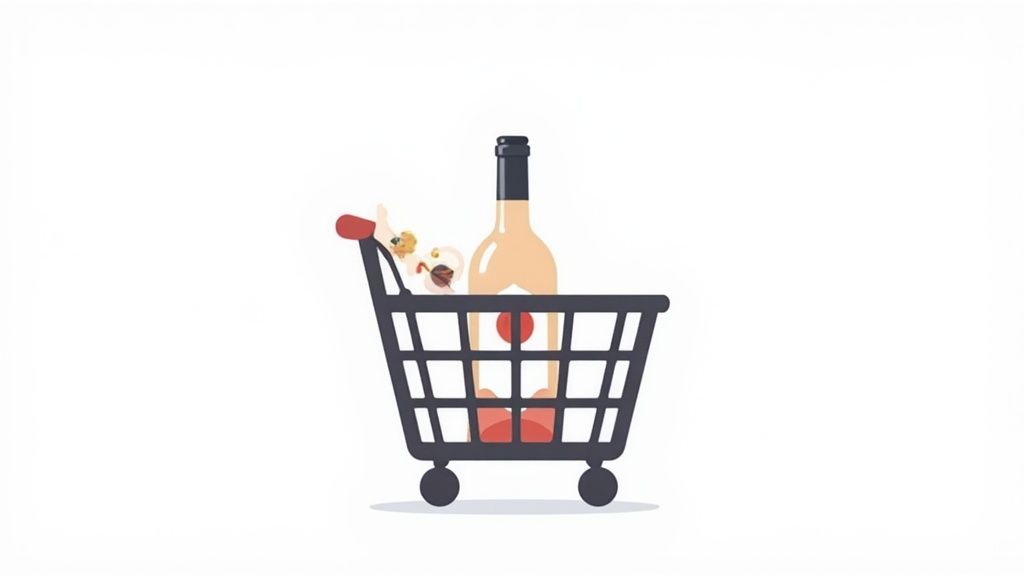
As you start exploring the world of preservative free wine, it's natural for a few questions to pop up. Let's tackle some of the most common ones to clear up any lingering doubts.
Does Preservative Free Wine Spoil Faster?
Yes, it generally does have a shorter shelf life. Without the helping hand of sulphites to act as a stabiliser, the wine is much more vulnerable to oxygen. Think of it like a freshly baked loaf of bread versus a store-bought one – it's crafted to be enjoyed at its peak, young and fresh.
Once you pop the cork, that vibrant character starts to fade a bit quicker than you might be used to. Your best bet is to stick it in the fridge and enjoy the rest within 24-48 hours. This will ensure you catch all those intended flavours and aromas before they begin to diminish.
Is Organic Wine Always Preservative Free?
Not necessarily, and this is a really important distinction to make. The term ‘organic’ is all about what happens out in the vineyard – how the grapes are farmed. It means they're grown without synthetic pesticides or fertilisers.
While many winemakers who farm organically also choose to add no preservatives, the organic certification itself doesn't forbid them. It just sets much lower allowable limits. To be absolutely sure, always look for a specific "Preservative Free" or "No Added Preservatives" statement right on the label.
Will Preservative Free Wine Prevent a Hangover?
If only it were that simple! Unfortunately, a hangover is primarily caused by dehydration and the way our bodies metabolise alcohol itself.
While skipping sulphites might help you avoid specific reactions like headaches if you're sensitive to them, drinking any type of alcohol can still lead to a hangover. The only surefire prevention is to drink in moderation and keep yourself hydrated with plenty of water.
Ready to explore the pure, vibrant flavours of McLaren Vale? Browse our curated collection of premium wines at McLaren Vale Cellars and discover your next favourite drop. Shop the range today!
Article created using Outrank

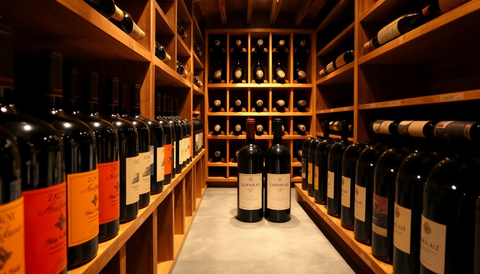
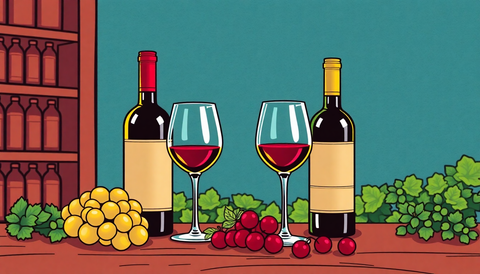

Comments (0)
There are no comments for this article. Be the first one to leave a message!